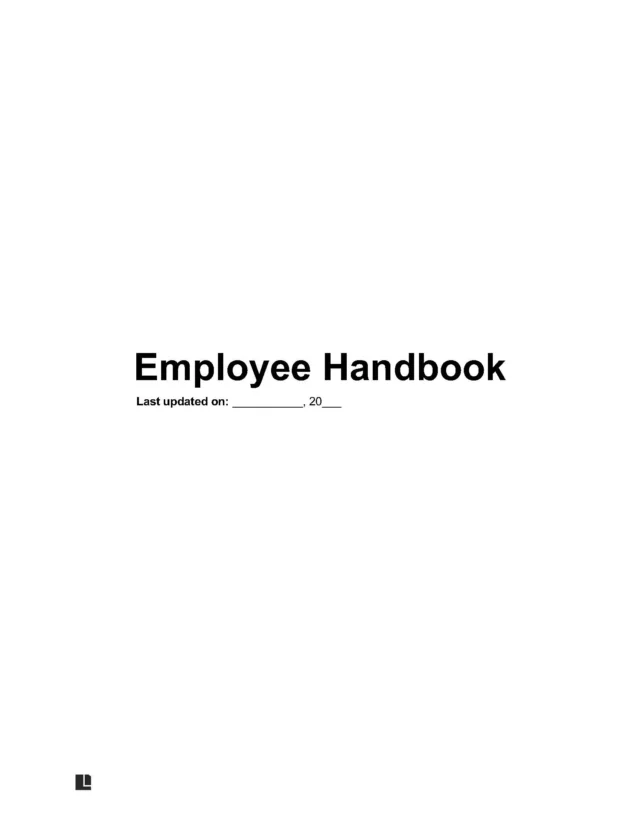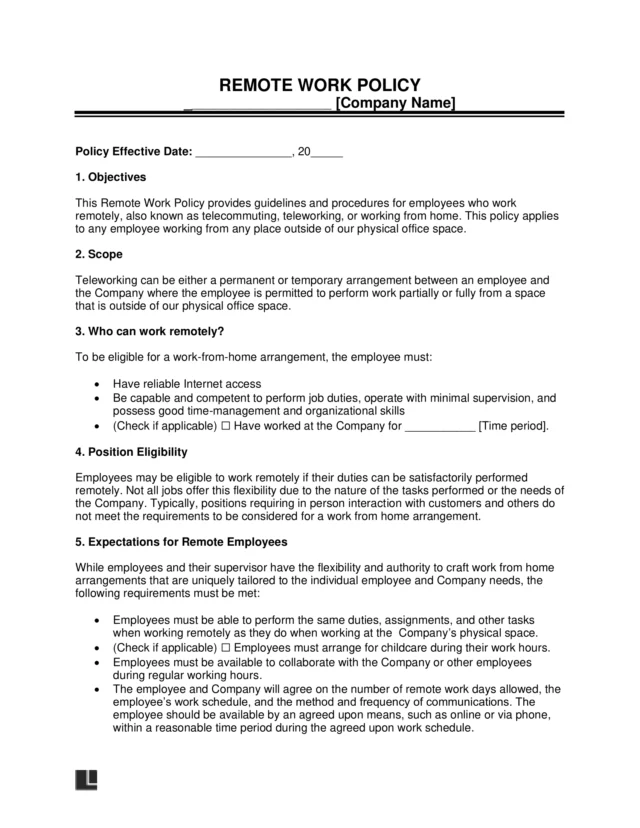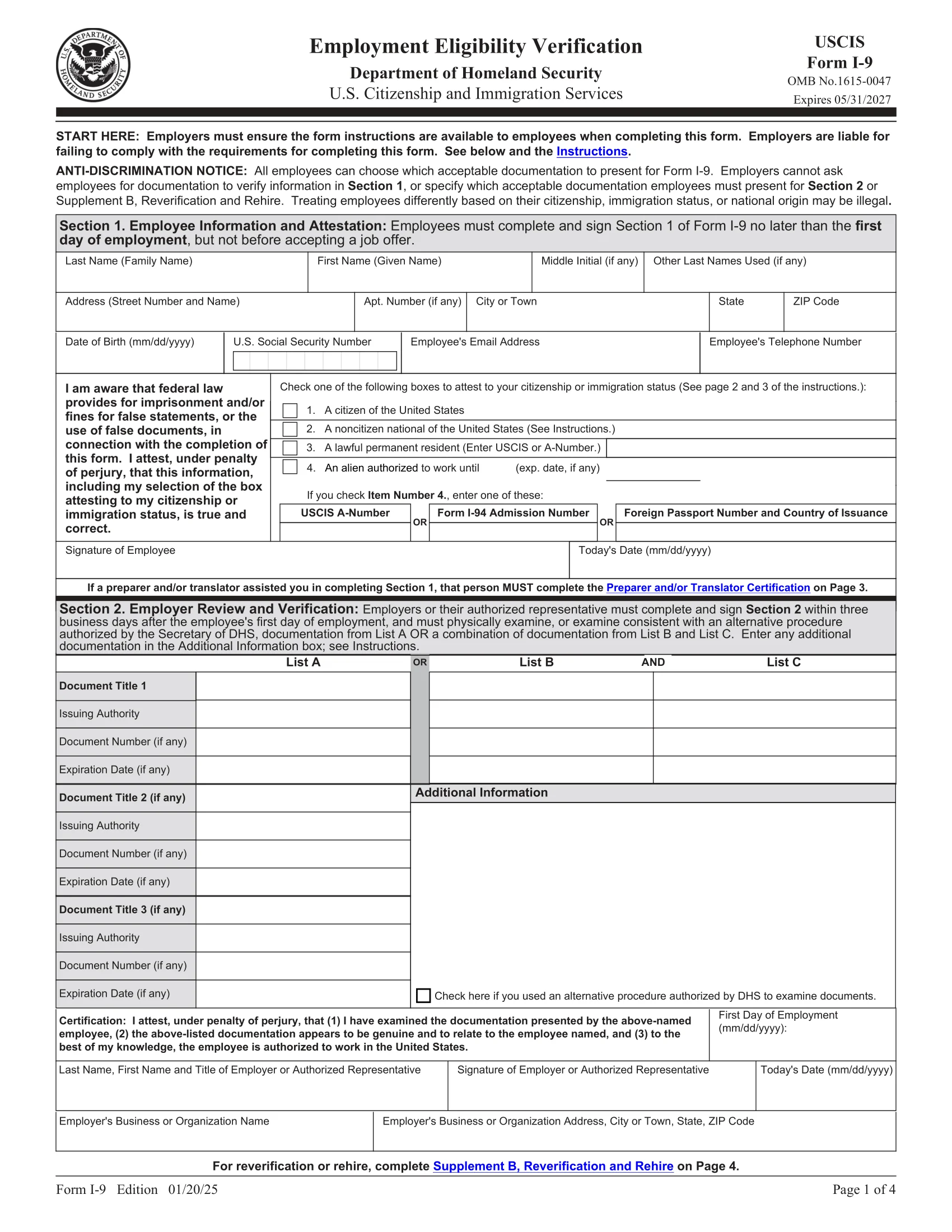What Is Form I-9?
Form I-9 is an employment eligibility verification form used by employers to ensure their hired workers have the legal right to work in the US. The United States Citizenship and Immigration Services (USCIS) requires employers to complete the verification within three business days of the worker’s employment start date. An I-9 form requires the employee to provide personal information, and the employer then verifies the employee’s documents.
Legal Templates free 2025 form I-9 template displays the proper formatting and information for a compliant form.
Planning to use a vendor or contractor to support your business activities? Make sure you collect their tax information using the W-9 Form.
Changes to Form I-9 for 2025
- While Form I-9 remains mostly unchanged, the 2025 paperwork includes a few notable updates to the language:Box 4 of the form has been changed from “a noncitizen authorized to work” to “An alien authorized to work.”
- The term “gender” has been replaced with “sex” in the descriptions of items under List B of acceptable documents.
- A revised DHS Privacy Notice was issued for Form I-9 in 2025.
How to Fill Out Form I-9
Filling out Form I-9 begins with the employee entering their personal information, which is then provided to the employer for verification and filing. Use the following steps to simplify the process and complete your form.
1. Collect the Employee’s Information
Begin by providing your employee with a copy of Form I-9 and its accompanying instructions. Ask them to complete Section 1 with their name, address, and contact details, Social Security number, and current citizenship or immigration status. They then sign and date Section 1.
Employers may provide the form during the hiring process or immediately after hiring. Workers may need some time to gather their documentation, so it’s a good idea to share the form before their first day, as the instructions require this section to be completed by the end of the first day of employment. If a third party assists an employee in preparing or translating their I-9 Form, use Supplement A to record the preparer’s name, signature, and contact information.
Try including Form I-9 with a new worker’s job offer letter or employment contract.
2. Verify the Employee’s Documents
Section 2 asks you or an authorized representative to examine your new employee’s identity and work authorization documents. List the documents you reviewed, along with the issuing authority and expiration date for each one. Acceptable documentation includes one item from List A or one document from List B and C. If the documentation appears genuine, relates to the worker, and is not expired, you can accept it.
Employers can only approve actual documents, not photocopies. The only exception is for certified copies of a worker’s birth certificate. This verification and section must be completed within three days of the employee’s start date.
Using an e-verification tool streamlines the documentation review process. It’s especially useful if you plan on hiring remote workers.
3. Retain Form I-9
Once you and your employee have completed and signed the form, you’ll keep it for your records. The completed I-9 does not need to be submitted to any government agency. However, you should retain Form I-9 for as long as you employ your new team member. Once an employee leaves the job, you should keep it for an additional year or up to three years after their first day of employment, whichever is longer.
4. Reverify an Employee’s Work Authorization
Employers may need to reverify an employee’s work authorization on Supplement B if their documentation expires. Re-verification applies only to individuals with temporary work authorization, not US citizens or permanent residents.
The USCIS recommends notifying employees at least 90 days prior to their work authorization expiring, allowing they sufficient time to obtain new documents. If you rehire an employee within three years of their initial hiring date, you may use Supplement B to reverify employment eligibility.
5. Store Form I-9 Securely
Once you finish the I-9 process, be sure to save a digital or paper copy for your records. You’ll need it if the USCIS or a law enforcement agency asks to see it.
Legal Templates provides a hassle-free solution for saving and storing documents. Use our Form I-9 template, then print or save it electronically.
Documents Required for Form I-9
To verify work eligibility, employees must present documentation from the USCIS-approved lists. This can be done by either providing one document from List A or by providing one document from List B and another from List C.
List A
List A documents prove an individual’s identity and US work authorization:
- US passport or US passport card
- Permanent Resident Card or Alien Registration Receipt Card (Form I-551)
- Foreign passport containing a temporary I-551 stamp
- Temporary I-551 stamp or notation on an immigrant visa
- Employment Authorization Document (Form I-766), including a photograph
- Foreign passport and Form I-94 or Form I-94A that confirms an individual’s immigration status and doesn’t violate any restrictions or limitations of the form.
List B
List B documents establish your employee’s identity:
- State-issued driver’s license or ID card, or such license or ID from a US territory or possession
- Federal, state, or locally issued ID card containing a photograph or personal information such as name, birthday, gender, height, eye color, and address.
- School ID that includes a photograph
- Voter’s registration card
- US military ID or draft record
- Native American tribal document
- Military dependent ID card
- US Coast Guard Merchant Mariner Card
- Driver’s license from a Canadian governmental authority
If an employee is under the age of 18 and doesn’t have any of the above identity documents, they may provide school or medical records, such as a report card or hospital record, as an alternative.
List C
Documents from List C prove a new employee’s eligibility to work within the US:
- A Social Security card, as long as it doesn’t contain any employment or work restrictions
- Birth certificate issued by the Department of State
- Original or certified copy of a birth certificate from a state, county, municipal authority, or US territory containing an official seal
- Native American tribal document
- US Citizen ID card (Form I-197)
- Form I-179, Identification Card for Use of Resident Citizen in the US
- Employment authorization document issued by the Department of Homeland Security
Along with the above documents, employees can use options like a Certification of Birth Abroad, a certified birth certificate, or an employment authorization document. For those under 18, school or medical records are also acceptable forms of identification. Ensure that all documents are from the approved USCIS list, genuine, and unexpired.
Penalties for Non-Compliance With Form I-9
Complying with Form I-9 rules protects your business and ensures a smooth hiring process. Failure to file or properly complete these forms may result in civil fines or debarment from federal contracts for the employer. In addition, if the Department of Homeland Security (DHS) proves a pattern of failing to collect Form I-9 verifications, you could face criminal charges.
The DHS oversees these penalties, and fines or criminal charges vary based on the severity of the violation, the business’s good faith, and other factors. If the federal government finds technical errors in any Form I-9s, it may grant the employer up to 10 days to make corrections and become fully compliant.
Anti-Discrimination Protections Related to Form I-9
The USCIS adheres to anti-discrimination laws, particularly those related to Form I-9. Activities that may break regulations include:
- Asking an employee for extra documents besides what’s listed on Form I-9
- Using a worker’s I-9 documentation in a hiring, firing, or recruitment decision
- Discriminating against an employee based on their immigration status, citizenship, or nationality
For example, requiring new employees to supply two List A documents might be discriminatory. The USCIS requests only one List A document and provides employees with the option to supply evidence from Lists B and C.
Sample Form I-9
Use Legal Templates’ sample Form I-9 to view the proper structure and required information. Then, complete yours online using our guided form and download your copies in PDF format.






